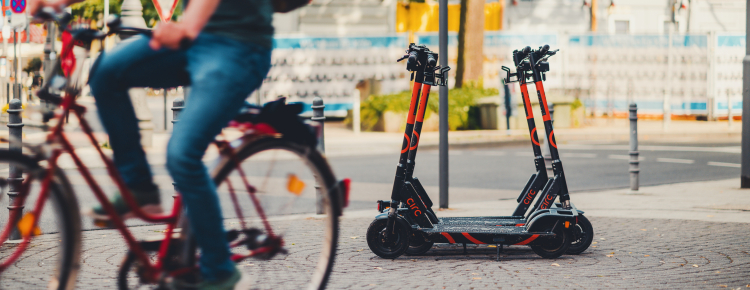
Have electric scooters whizzed into your city yet? Smartphones and other IoT advancements have paved the way for shared rides to expand beyond car travel. Now, alternative transport methods are popping up in cities across the globe, with less CO2 emissions than automobiles.
Cities focused on sustainability are looking into how micromobility can solve transportation issues that have long plagued urban areas. Read on to discover the pros and cons of micromobility and how city infrastructure can enhance it.
What is micromobility?
Micromobility is designed to replace short car rides by using smaller, more lightweight vehicles driven at speeds less than 15.53 mph to get around. Many of these transportation options aren’t new, but smartphones are making them more accessible.
Rather than buying a bicycle or scooter of your own, you can rent one nearby with just a few clicks of a button. Once you’re done with the ride, you then leave the vehicle at your destination. This ease of use allows micromobility to offer last-mile solutions, helping commuters get to nearby public transit stops more easily.
Popular forms of micromobility include:
- Bicycles
- E-bikes
- Dockless scooters
- E-skateboards
How city infrastructure can improve micromobility
As shared micromobility rolls out, new rules and infrastructure can help pave the way for success. Micromobility paths, more protected lanes for riders, and data centers are just some of the ways cities can promote the use of alternative transportation.
More protected bike lanes
Why don’t more people bike to work? Cycling safety concerns play a major role. While many cities have some form of protected bike lanes already in place, expanding these to meet demand will allow for more micromobility travel while also giving sidewalks back to the pedestrians.
COVID-19 has caused an increase in demand for protected bike lanes as people have been spending more time outside — for example, one bike trail in Philadelphia saw usage increase 417% during the start of the pandemic.
Cycle superhighways
Bike-friendly cities in Europe, such as Copenhagen and London, have expanded infrastructure beyond protected lanes and created cycle superhighways. These bike freeways allow for higher speed rides on paths that don’t have street lights or vehicle congestion.
This can make commuting to work on micromobility just as fast (or even faster) than cars. The cycle superhighways are also much safer for cyclists and other travelers, as automobiles are taken out of the equation.
Data-sharing platforms
Shared micromobility is often activated by an app on a smartphone. Because of this, a lot of real-time data is gathered when a user rents and rides. Processing this information can help cities understand how micromobility is being used and in what neighborhoods.
Cities looking to keep tabs on micromobility can collect and analyze this data to help manage fleet numbers, regulate parking issues, spot service gaps and more. It can also answer questions around accessibility, such as revealing whether low income communities have access to shared micromobility in their neighborhoods.
Car-free streateries
Taking another page out of Europe’s book, car-free “streateries” are on the rise in America thanks to COVID-19. Heavily trafficked areas around restaurant and shopping districts are being closed off to car travel in order to expand dining into the streets. This is helping provide more space for social distancing, allowing small business owners to stay open safely.
So where does micromobility come in? Rather than driving up to these streateries with a car, visitors can ride up to their destination on micromobility transportation. This also helps solve parking issues and reduces traffic gridlock in cities.
While micromobility does offer a new transportation solution, there are cons and issues that still need to be addressed. This is why many metropolitan areas are still in test pilot mode for e-scooter adoption.
After all, how can consumers safely use micromobility? Who foots the bill when an accident does happen? How do you prevent micromobility transport options from littering the streets?
Expect to see the issue of micromobility travel debated and regulated throughout metropolitan areas in the years to come. Despite some drawbacks, they won’t be whizzing away anytime soon.
___________
This article was originally published on The Zebra under The future of micromobility: How short, shared rides are disrupting car travel.

